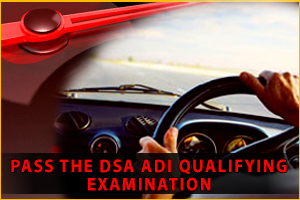
ADI Training:
The Driving Standards Agency (DSA) is an executive agency of the Department of Transport. The agency is responsible for conducting all theory and practical driving tests in Great Britain.
To become an ADI you need to pass the DSA ADI qualifying examination and meet certain minimum legal requirements. Namely, you must:
- Hold a full UK or EEA unrestricted car driving license.
- Have held it for at least 4 years prior to entering the Register after qualifying.
- Not have been disqualified from driving at any time in the 4 years prior to being entered in the Register.
- Be a ‘fit and proper’ person to have your name entered in the Register. All convictions, motoring or non-motoring still in force will be taken into account by the DSA before allowing you on the Register. From experience we know that anyone with 6 or more points on their license within the last 4 years prior to entry on the Register is likely to be rejected.
You must ensure you can read a number plate in good daylight at the distance of 27.5 metres or 26.5 metres depending on the width of the lettering (with glasses if normally worn for driving) as this will be checked on Part 2 of the qualifying examination. On the normal driving test you need only read a number plate at 20.5 metres or 20 metres depending on the width of the lettering.
Please also note on the Part 2 driving test you must be able to take rear observations by looking round when reversing without heavy dependency on the mirrors. So if you have minimal neck movement this will need to be checked before you start, as you are not allowed additional mirrors as on the ordinary driving test.
The ADI qualifying examination:
The DSA ADI qualifying examination is in three parts:
Part 1: Theory – consists of a multiple-choice test and a video based hazard perception test.
Part 2: Driving – consists of an eyesight test, two questions about carrying out safety checks on the vehicle followed by a practical driving test.
Part 3: Instructional ability – consists of a practical test of the ability to instruct.
Once you have passed Part 1 you are required to undertake and pass the two remaining parts within two years. You are permitted an unlimited number of attempts at Part 1. However, for Part 2 and Part 3 you are only allowed three attempts at each test. Should you fail a third attempt at Part 2 or Part 3 you would have to restart qualification again after 2 years had elapsed from your Part 1 pass date.
Waiting time for Part 1 is minimal; however, you will need to wait 6 to 8 weeks for either a Part 2 or Part 3 test appointment. This is why intensive training for Part 2 and 3 is unsuitable and why it is better to spread out the training over several weeks on a part-time basis with lots of practice in between.
Part 1: Theory
Multiple Choice Section :
This section tests you knowledge of the Highway Code and other instructional matters via a Personal Computer and lasts for 90 minutes. You are asked 100 questions with optional voice over. For each question four answers are shown on the screen and you are required to select the answer you think is correct. To pass you are required to answer 85 questions correctly overall (including 20 within each of the 4 subject groups tested, also known as bands). The DSA provide a full list of all the questions and associated answers used so that training companies can incorporate then into their revision programmes.
Hazard Perception Section :
This section tests you ability to identify moving hazards ahead that are likely to cause you to slow down, stop or change direction. The test requires you to watch 14 video clips, each filmed from the drivers eye view of a car as it drives down the road. Each time you see a moving hazard start to develop you would click the computer mouse button to let the program know you have seen the problem. The earlier you see the warning signs and click the mouse button the higher your score will be. A maximum of 5 can be scored on any hazard and a total of 15 hazards are show, at least 1 per clip, with one clip having 2. To pass this test you have to score 57 out of a maximum possible score of 75 (i.e. 15×5).
Part 2: Driving
As from the 10th August 2005 your examiner will ask you to describe how to perform a check on the condition and safety of three components of the vehicle and demonstrate an actual check on the condition of a further two components.
The driving test closely resembles the current car-driving test for learners in format and content. However, the eyesight test requires you to see a number plate at a slightly longer distance (i.e. 27.5 metres or 26.5 metres depending on the width of the lettering), the duration of the test is longer to allow you to undertake all the set manoeuvres and you are expected to perform to a higher standard. Unlike the L test you are only permitted a maximum of 6 minor driving faults and what constitutes a minor driving fault may be more harshly assessed.
Part 3: Instructional ability
The test requires you to give two half-hour driving lessons on subjects chosen by the examiner. The examiner plays the role of a pupil and whilst in that role he or she tests your ability as an instructor by asking questions and making mistakes. In particular, the examiner will expect you to explain the objectives of the lesson and give a briefing where required, provide appropriate verbal support while on the move to aid the learning process and to identify and deal with any faults that might occur. Your performance for each lesson will be graded from 1 to 6 with grade 4 and above being a pass. Therefore the minimum you need to pass part 3 is a 4/4. Grade 4 is adequate, grade 5 is good and grade 6 is excellent.


